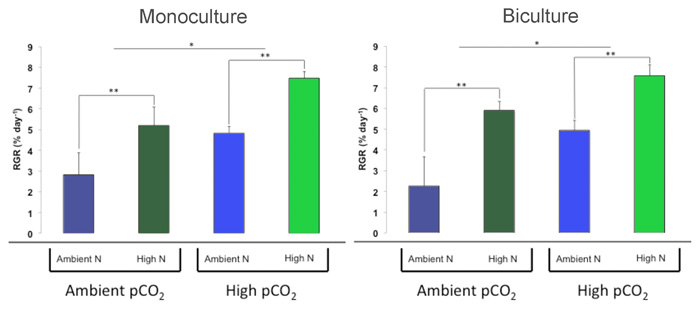| Tweet | Follow @co2science |
Paper Reviewed
Ober, G.T. and Thornber, C.S. 2017. Divergent responses in growth and nutritional quality of coastal macroalgae to the combination of increased pCO2 and nutrients. Marine Environmental Research 131: 69-79.
One of the more troubling claims of climate alarmists is the potential impact of so-called ocean acidification on marine life, where it is predicted that a small 0.1 to 0.3 unit decline of seawater pH (projected to occur over the course of the next eight decades) will wreak havoc on an untold number of ocean species. Such havoc typically includes estimates of declines in growth, fertility, fitness and species survival. Consequently, in light of such projections, scientists have been studying in earnest the response of marine species to changes in seawater pH in laboratory settings for several years now.
Working with two macroalgae species, Ober and Thornber (2017), investigated the response of elevated CO2 (i.e., ocean acidification) and nutrient loading on a fast-growing green (Ulva spp.) and slow-growing brown (Fucus vesiculosus Linneaus) algae at a flow-through seawater facility of the U.S. Environmental Protection Agency (Atlantic Ecology Division, Narragansett, Rhode Island) over a period of three weeks. More specifically, the two macroalgal species were grown in both monoculture and biculture under either ambient (400 µatm) or elevated (1100 µatm) CO2 and with either ambient (4 µM) or elevated (80 µM) nitrate supply of nutrient loading. It was the objective of the two researchers to quantify the interaction of CO2 and nutrients on the two species by assessing their growth rates, tissue quality and potential competitive effects when grown together.
Did ocean acidification have the presumed negative effect on these species that climate alarmists are so quick to claim?
In a word, no. Ober and Thornber observed no negative impact of elevated pCO2 or nutrient level on the relative growth rate of Fucus. In contrast, as shown in the figure below, elevated CO2 and nutrient level both had positive impacts of the growth rates of Ulva, increasing the relative growth rates by 70% and 125% under ambient nutrient supply in the monoculture and biculture treatments, respectively, and by 44% and 54% under high nutrient supply in the monoculture and biculture treatments, again respectively.
With respect to tissue quality, the authors report that "both species exhibited a decline in carbon to nitrogen ratios (C:N) with elevated nutrients, but pCO2 concentration did not alter tissue quality in either species." Thus, they conclude that "nutrients are the key driver of C:N ratios in Ulva and Fucus."
Finally, in summing up their findings, Ober and Thornber say that "the combination of ocean acidification and nutrients will enhance abundance of opportunistic algal species in coastal systems," such as Ulva as demonstrated here. And as for Fucus, the lack of any direct, negative effect of ocean acidification on this species is equally good news for its future.

Figure 1. Relative growth rate (RGR, % per day) of Ulva grown in monoculture (left panel) and biculture with Fucus (right panel) under ambient (400 µatm) or elevated (1100 µatm) pCO2 and with either ambient (4 µM) or elevated (80 µM) nitrate supply (* represents p < 0.001, ** represents p < 0.0001). Source: Ober and Thornber (2017).




